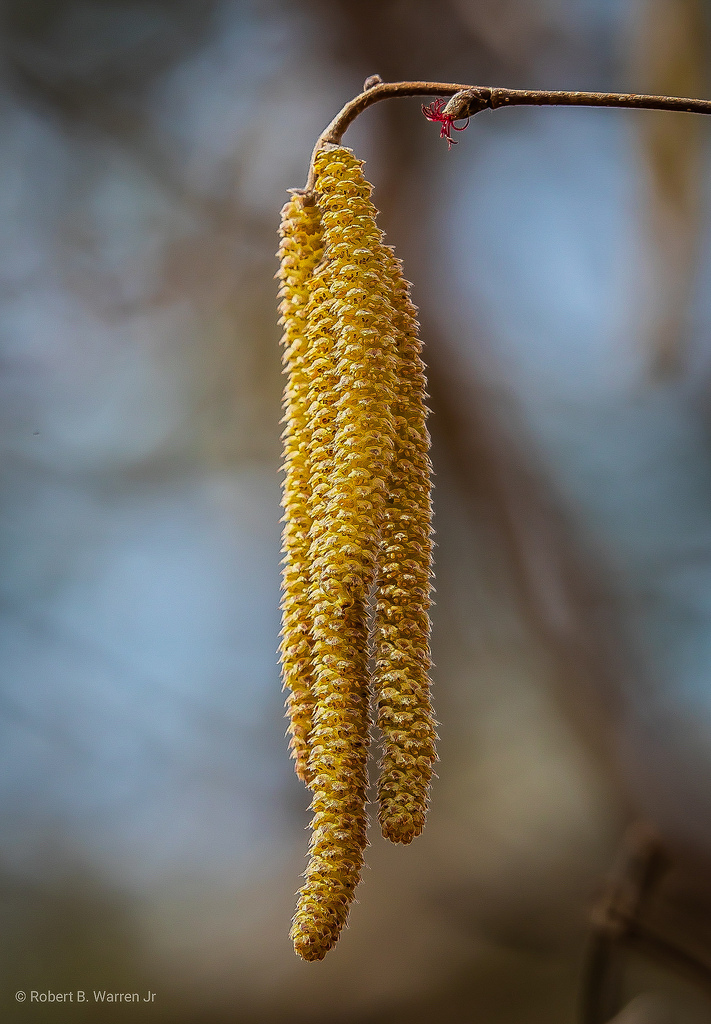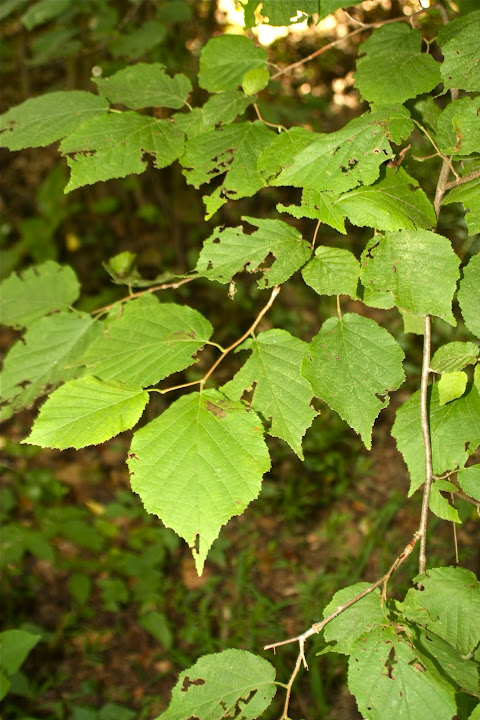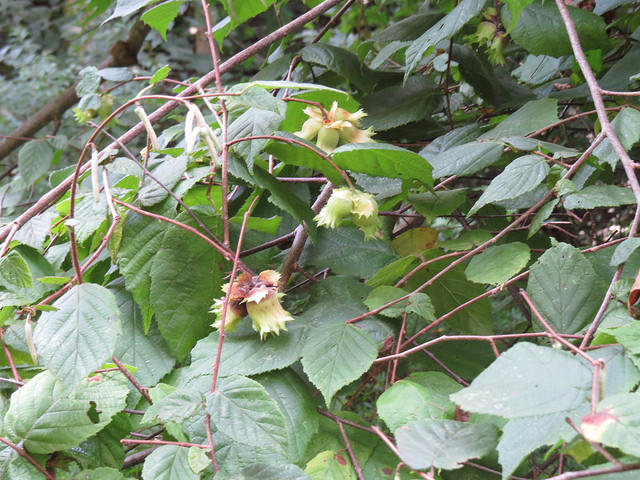Map Snapshot















88 Records
Status
A small tree or multi-stemmed shrub native to Maryland and much of the rest of eastern North America. It is related to another Maryland native, the Beaked Hazelnut, which grows mainly in the mountains. (The commercial filbert nuts are produced by several non-native Corylus species.) American Hazelnut grows in or forms thickets, often in moist soil (Brown and Brown, 1972).
Description
In the spring, the male catkins, which have overwintered, elongate and become more obvious; the female flower bud opens to reveal small, red, inconspicuous flowers. The nuts are in clusters of two to five. Each nut is about ½ inch long and is surrounded by two broad, leaf-like, ragged-edged bracts which open down to the round, bony-shelled nut. The bracts much exceed the nut in size but do not extend into an elongated beak, as in Beaked Hazelnut. The nuts are initially green, ripening to brown in late summer. If not eaten by wildlife, they may persist on the plant into the next growing season.
Where To Find
Often occurs along streams. Not common on the Coastal Plain.
Relationships
The fruits are not obvious because they are hidden beneath the leaves, but that does not stop squirrels and other wildlife, which are very fond of the nuts.
Host plant to various moth species including the Buck Moth (Database of the World's Lepidopteran Hostplants).
Host for the leaf beetle Calligrapha rhoda.
Seasonality Snapshot
Source: Wikipedia
| Corylus americana | |
|---|---|

| |
| Scientific classification | |
| Kingdom: | Plantae |
| Clade: | Tracheophytes |
| Clade: | Angiosperms |
| Clade: | Eudicots |
| Clade: | Rosids |
| Order: | Fagales |
| Family: | Betulaceae |
| Genus: | Corylus |
| Species: | C. americana
|
| Binomial name | |
| Corylus americana Marshall, 1785
| |

| |
| Distribution of American hazelnut | |
Corylus americana, the American hazelnut[3] or American hazel,[4] is a species of deciduous shrub in the genus Corylus, native to the eastern and central United States and extreme southern parts of eastern and central Canada.[3][5]
Description
[edit]The American hazelnut grows to a height of roughly 2.5 to 5 m (8 to 16 ft),[6] with a crown spread of 3 to 4.5 m (10 to 15 ft). It is a medium to large shrub, which under some conditions can take the like of a small tree. It is often multi-stemmed with long outward growing branches that form a dense spreading or spherical shape. It spreads by sending up suckers from underground rhizomes 10 to 15 cm (4 to 6 in) below the surface.[7]
It blooms in very early[3] to mid spring,[8] producing hanging male (staminate) catkins 4 to 8 cm (1+1⁄2 to 3+1⁄4 in) long, and clusters of 2–5 tiny female (pistillate) flowers enclosed in the protective bracts of a bud, with their red styles sticking out at the tip.[3][9] The male catkins develop in the fall and remain over the winter. Each male flower on a catkin has a pair of bracts and four stamens.[8][10]
American hazelnut produces edible nuts that mature at a time between July and October. Each nut is enclosed in two leaf-like bracts[10] with irregularly laciniate margins.[3]
-
Small bud-like female flowers and hanging male catkins
-
Fruit cluster (nuts enclosed in leaflike bracts)
Ecology
[edit]The nuts produced by American hazelnut are a mast of squirrels, whitetail deer, foxes, ruffed grouse, northern bobwhites, pheasants, turkey, woodpeckers, and other animals. The leaves are browsed on by whitetail deer, moose, and rabbits. The male catkins are a food staple of ruffed grouse and turkey throughout the winter. The low-hanging shrubs form habitat for many animal species. [citation needed]
Uses
[edit]The nuts are edible raw,[11] although smaller than the more commonly cultivated filberts (Corylus maxima,[3][12] Corylus colurna,[3] Corylus avellana,[12] and hybrids thereof).[12]
Native Americans used Corylus americana for medicinal purposes, such as hives, biliousness, diarrhoea, cramps, hay fever, childbirth, hemorrhages, prenatal strength and teething, to induce vomiting and to heal cuts.[3]
Cultivation
[edit]Corylus americana is cultivated as an ornamental plant for native plant gardens, and in wildlife gardens to attract and keep fauna in an area. There are cultivated hybrids of Corylus americana with Corylus avellana which aim to combine the larger nuts of the latter with the former's resistance to a North American fungus Cryptosporella anomala.[12]
It is a medium to fast-growing species, that suckers moderately, eventually producing a multi-stemmed, clump appearance.[citation needed]
It adapts well to a range of soil pH and types, but does best on well-drained loams. American hazelnut prefers full sun for best growth and development. Though it can grow and persist in partial shade, plant density and fruit production are greatly reduced.[citation needed]
References
[edit]- ^ Stritch, L. 2014. Corylus americana. The IUCN Red List of Threatened Species 2014: e.T194257A2307102. https://dx.doi.org/10.2305/IUCN.UK.2014-3.RLTS.T194257A2307102.en. Accessed on 06 July 2023.
- ^ "Corylus americana. NatureServe Explorer 2.0". explorer.natureserve.org. Retrieved 6 July 2023.
- ^ a b c d e f g h Furlow, John J. (1997). "Corylus americana". In Flora of North America Editorial Committee (ed.). Flora of North America North of Mexico (FNA). Vol. 3. New York and Oxford: Oxford University Press – via eFloras.org, Missouri Botanical Garden, St. Louis, MO & Harvard University Herbaria, Cambridge, MA.
- ^ "Corylus americana". Germplasm Resources Information Network. Agricultural Research Service, United States Department of Agriculture. Retrieved 2018-07-23.
- ^ "Corylus americana". County-level distribution map from the North American Plant Atlas (NAPA). Biota of North America Program (BONAP). 2014.
- ^ "Corylus americana". Missouri Botanical Garden. Retrieved 2016-07-05.
- ^ Coladonato, Milo (1993). "Corylus americana". Fire Effects Information System (FEIS). US Department of Agriculture (USDA), Forest Service (USFS), Rocky Mountain Research Station, Fire Sciences Laboratory.
- ^ a b Hilty, John (2020). "American Hazelnut (Corylus americana)". Illinois Wildflowers.
- ^ Chayka, Katy; Dziuk, Peter (2016). "Corylus americana (American Hazelnut)". Minnesota Wildflowers.
- ^ a b Furlow, John J. (1997). "Corylus". In Flora of North America Editorial Committee (ed.). Flora of North America North of Mexico (FNA). Vol. 3. New York and Oxford: Oxford University Press – via eFloras.org, Missouri Botanical Garden, St. Louis, MO & Harvard University Herbaria, Cambridge, MA.
- ^ Elias, Thomas S.; Dykeman, Peter A. (2009) [1982]. Edible Wild Plants: A North American Field Guide to Over 200 Natural Foods. New York: Sterling. p. 173. ISBN 978-1-4027-6715-9. OCLC 244766414.
- ^ a b c d Bailey, Liberty Hyde; Bailey, Ethel Zoe (1976). Hortus third : a concise dictionary of plants cultivated in the United States and Canada. New York: Macmillan. p. 479. ISBN 0-02-505470-8. OCLC 2513407.
External links
[edit]- Corylus americana Photos, drawings, description from Nature Manitoba.

























